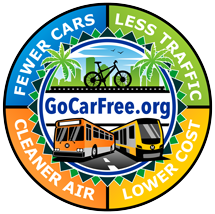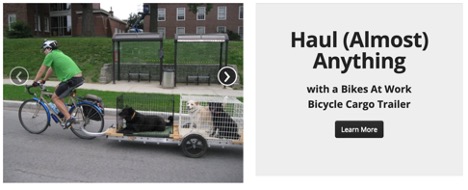
Lesson 23
Think Outside the Metal Box: Special Situations Require Creativity
“Creativity involves breaking out of established patterns in order to look at things in a different way.”
– Edward de Bono, Psychologist & Inventor
If you’re a lifelong car owner thinking about going car free for the first time, you may be having skeptical thoughts, even a little anxiety.
“If I don’t have a car, how will I haul my kayak to the lake?” “How will I get my dog to the vet?” “What if I have a medical emergency?”
These concerns are understandable, but each has a car free solution. The following are a few questions people commonly have about handling special situations, along with some car free solutions.
How will I get to the airport?
All commercial airports are served by public transit. If you can get to a transit stop you can get to your local airport. Remember, many people who own cars still take mass transit to the airport because parking there is so expensive.
Many airports are also served by private shuttles. In Los Angeles, the airport shuttle is called the LAX FlyAway Express. It costs only $9.75 and leaves from several public transit hubs including Los Angeles Union Station.
Uber and Lyft also serve all the major airports.
What about travel to other cities?
For long road trips to other cities you could plan a rental car weekend. But my first choice would be to carpool with friends, if possible.
For example, from Los Angeles it’s about a five-hour drive to Mammoth Mountain ski area. Whenever we go we always carpool with another couple. Sometimes they drive their car, and we pay for gas. Other times we rent a car and drive, and they pay for gas.
Greyhound (www.Greyhound.com) and Amtrak (www.Amtrak.com) are both excellent forms of car free ground transportation. And both offer frequent discounts and special deals.
I once took Greyhound from St. Louis to Cincinnati for a long weekend for just $45. Renting a car with unlimited miles and paying for gas would have cost me three times that.

How will I get my kayak to the lake, or move something really heavy?
A kayak is light enough that you could easily transport one by bicycle if you have the proper equipment. Take a look at the website BikesatWork.com. It offers tips on hauling heavy loads, and it has bike trailers for sale that are large enough to tow a sailboat.
According to bikesatwork.com, “Most people underestimate how much they can transport using their own muscle power. With the right equipment, it is easy to move loads too large for an automobile.”
If the lake is too far to reach by bicycle, or if you don’t want to buy a bike trailer, you can always rent a vehicle. That’s one of the benefits of renting instead of owning: you can get exactly the type of vehicle you need. In this case, a pickup truck, a van, or an SUV with a roof rack.
My friends who are really into kayaking go about eight times a year, so it’s much cheaper to rent a vehicle than to own one for that specific purpose.
Even if you rented a truck twenty weekends a year at a cost of $150 per weekend, it would still be way cheaper than owning one. And when you rent, you get a brand-new truck every time.

How will I get my dog or cat to the vet?
Most public transit systems allow pets as long as they are in a pet carrier. Uber has an option for “Uber Pet” when you order a ride on the app. Many people transport pets in a bicycle trailer (for large dogs), or in a bicycle basket (for smaller dogs and cats). Apparently the animals enjoy this type of travel.
Another way to transport a large dog while cycling is in a bike trailer. There are a wide range of companies that make bike trailers specifically designed to keep dogs safe and sound while cycling.
I have never done it, but I did buy a Burley dual-child bike trailer to transport my two daughters. It’s a really easy and convenient way to carry precious cargo – or any cargo for that matter.
For more information on bicycle trailers and baskets, visit Burley.com. Cynthiastwigs.com specializes in comfortable bicycle baskets for smaller dogs weighing up to twenty pounds. Another company, Wicycle.com, sells trailers specifically built for dogs in a range of sizes.
Here is a video review of the Burley Tail Wagon from Suits2Sandals. It’s also a video of how they biked the entire East Coast Greenway 2,893 miles from Maine to Florida with their 68 pound Siberian Husky. Awesome!
What if my local transit system doesn’t allow bicycles?
Most transit systems do allow bikes on board. But if yours doesn’t, you could get a folding bike. When you get to the transit stop, fold up the bike, slip it into its custom-designed nylon carrying bag, sling it over your shoulder, and get on the bus or train.
For more information on folding bikes, visit Dahon.com, or BikeFriday.com.
Don’t I need a car to go on vacation?
With a little research you can find wonderful car free vacations. Bicycling tours through wine country (TrekTravel.com), dude ranches in Wyoming, Caribbean cruises, hiking in Alaska, and beachcombing in the Bahamas do not require cars.
There are myriad car free travel opportunities, which you will now be able to afford since you don’t have to pay for a car. Try a Google.com search under “car free vacations.”
If you decide you need a car for your getaway, rent one.
What if I need urgent medical care?
We all hope we’ll never encounter this situation. But if you do, keep a couple of things in mind.
If you’re injured badly when you’re at work, out with friends, at a conference, dining in a restaurant, or pretty much any place in public, someone will drive you to the emergency room. Probably paramedics will take you in an ambulance. Or a friend will drive you.
Even if you have a car, when you’re severely injured or even suffering mild chest pain you should not drive yourself to the hospital. That could result in disaster.
For the same reason, if you’re at home and you have a serious medical emergency, dial 911. An ambulance with trained paramedics can reach you a lot quicker than you can drive to the hospital.
Even if you have a less serious medical emergency – like a severe cut, a broken bone, or a fall – again, you shouldn’t drive yourself. Call an Uber or ask a friend to take you. This way if you get dizzy or pass out on the way to the hospital you won’t be behind the wheel at the time.
Keep in mind, too, that if you drove yourself to the hospital, you’d have to park your car somewhere and then walk to the ER. So it’s probably just as quick to wait a few minutes for a rideshare – which can drop you off right at the emergency room doors.
My wife is pregnant and we’ll eventually have to rush to the hospital for the delivery. How will we get there?
My wife and I have been through this twice. Both times when my wife was pregnant we booked a weekly car rental at Enterprise starting about two weeks before her due date. We installed an infant car seat in the rental, and waited. When the baby came we were ready. Everything went smoothly.
Luckily, you’ll have about nine months to plan a strategy for this one. If you live near family, that could be your first choice. But be sure you have a primary ride, a backup ride, and a second backup ride.
My wife and I do not have any family in California. So as described above, the easiest solution for us was to lock in a low rate on a weekly or monthly rental through Enterprise Rent-a-Car (Enterprise.com).
Enterprise offers substantial savings with their “Month or More Rental Plan.” This way you have a car sitting outside 24×7 during the several-week period in which the baby is likely to come. But you still don’t need to own a car.
Living car free involves reevaluating, re-thinking, rearranging, and streamlining some of your activities for creative problem solving and better efficiency.
What if I can get there, but it’s a real hassle?
You may eventually realize that a few of the things on your social calendar or your to-do list present bigger transportation challenges than others. Living car free involves reevaluating, re-thinking, rearranging, and streamlining some of your activities for creative problem solving and better efficiency.
Here’s an example. You might find it difficult to get to your pottery class at the art collective on the other side of town. If you’ve exhausted the transportation ideas suggested in this course, then you may want to consider some creative alternatives.
You could look for a new pottery class closer to home or near a transit stop. You could consider buying a pottery wheel of your own and turning your garage into a home studio (since you no longer need it for a car). Or you might consider taking up a new hobby altogether. Perhaps there’s a glassblowing studio or an artists’ guild in your neighborhood.
Change Is Part of Life
In this course we talk about the concept of lifestyle re-engineering. Really, that’s just a fancy word for change.
To live car free you will likely have to change some things. Change your habits. Change your way to work. Change your wardrobe. Change where you live. Change your daily routine. Change your attitude.
But as many of the great philosophers and scholars throughout history have said, change is good. Change helps us grow. Change moves us forward. Check out all the famous quotations about change on BrainyQuote.com.
Going car free will be one of those life changes that expands your world, helps you grow as a person, builds your personal resiliency, makes you stronger, and boosts your self-confidence.
